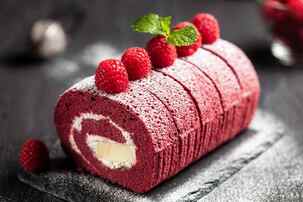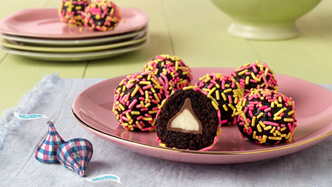…from the Perspectives’ Kitchen How you doin’? Tomorrow evening ends the weeklong Jewish celebration of Passover. To observe the holiday Jews around the world do not eat products made with leavening. If you’re a bread eater, you’re out of luck—this is strictly a Matzo holiday—no bread. If you’re a sweet eater there are many choices with Flourless Chocolate Cake being the favorite for many observers and non-observers who may also have a gluten intolerance. Among cake eaters, there are those who love the flourless chocolate cake in theory but pass on it because of its dense reality—more like a heavy chocolate ganache. My recipe version is perfect for them. It retains the bold interplay of bitter cocoa and sweet sugar that made the dessert famous, but all the heaviness is gone, thanks to the way some the way the eggs are incorporated with the other ingredients. When the cake comes out of the oven, it looks cracked and dry, but don’t fret, the inside will be soft and delicate. We think you will agree that running the knife through the perfectly light texture is super satisfying. The topping is made with a combination of mascarpone, heavy cream and confectioners’ sugar—it too is light and airy. It is subtle, with dairy sweetness notes—it melts in your mouth with each bite of cake. Make my Flourless Chocolate Cake for any special occasions. It’s decadent and special, but it’s so lightly sweet — and yes, even a little fluffy, too—that it’s the perfect end to a celebratory meal. Prep time: 25 minutes Bake time: 35 to 40 minutes Cool time: 20 to 30 minutes Yield: 8 servings Ingredients 1/2 stick unsalted butter, diced, plus more for buttering the pan 3/4 cup, plus 2 tablespoons granulated sugar, divided, plus more for coating pan 10 ounces roughly chopped bittersweet chocolate (I prefer Guittard chocolate) 2 tablespoons vegetable oil 4 large eggs, separated—yolks and whites 2 large eggs 2 tablespoons unsweetened dark cocoa powder (Guittard is best) 1 teaspoon pure vanilla extract (not imitation vanilla) 3/4 teaspoon kosher salt 1 cup chilled heavy cream 1/2 cup mascarpone 3 tablespoons confectioner’s sugar (I usually sift) 8 raspberries Directions To make the cake
To make the topping and top the cake
ChefSecret: The cake can be made 1 day ahead. Cover the pan in plastic wrap and store it at room temperature. Quip of the Day: Q. How do you drive your mother completely insane on Passover? A. It’s really a piece of cake! ------------------------------------------- Do you have a question or comment? Send your favorite recipes, pictures or thoughts to [email protected]. Recipes and cooking tips are posted on our website https://www.perspectives-la.com/covid-19-survival-guide. ------------------------------------------- To you and everyone dear to you, be strong, positive, stay well, stay safe and be kind. Take a breath and count your blessings, and if you have a little extra to share with others, please consider donating to Feeding America, Tunnel to Towers, Union Rescue Mission and/or American Red Cross. #Dessert #Baking #Passover #FlourlessChocolateCake #Unleavened #Guittard #CocoaPowder #NoFlour #Springtime #2024 #T2T #URM #FeedingAmerica #RedCross #PerspectivesTheConsultingGroup ©PERSPECTIVES/The Consulting Group, LLC, 2024
0 Comments
...from the Perspectives’ Happy Hour Bar |
For over 4 decades collaboration and vision have been the cornerstones of our approach to developing innovative solutions. We fuel innovation, uncover opportunities, discover trends and embrace sustainability, turning imaginative ideas into profitable realities. Categories
All
Archives
July 2024
|
www.perspectives-la.com
Copyright © 2021 Perspectives/The Consulting Group, LLC | Henderson, NV 89052 | 310-477-8877
Copyright © 2021 Perspectives/The Consulting Group, LLC | Henderson, NV 89052 | 310-477-8877






 RSS Feed
RSS Feed